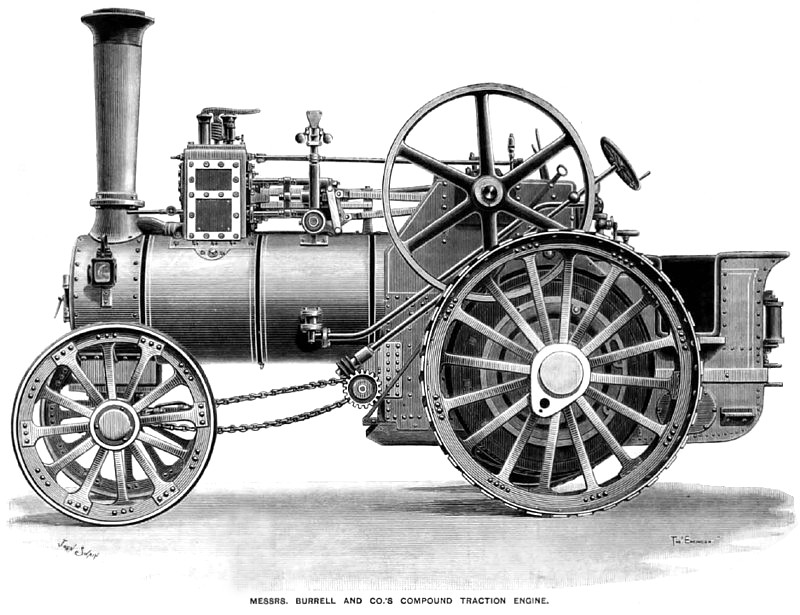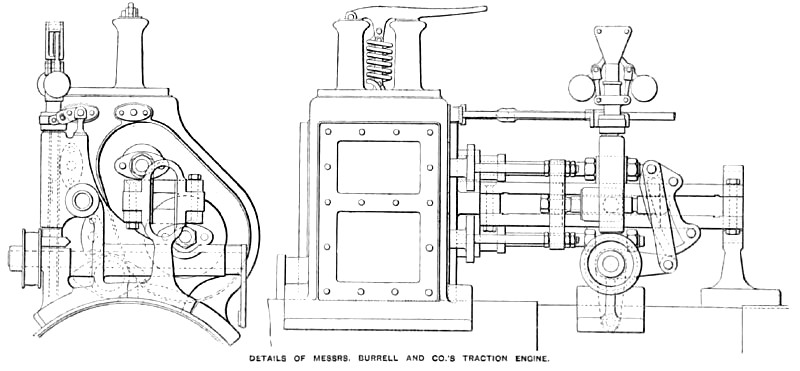|
Title: |
1890 Article-Charles Burrell & Sons, Ltd., Compound Steam Traction Engine |
|
Source: |
The Engineer Magazine, 12 Dec 1890 pg. 469 |
|
Insert Date: |
2/25/2013 10:38:26 PM |
We illustrate below a traction engine exhibited by Messrs. Burrell, of Thetford. We have noticed, but not described, this engine before, and it deserves particular mention because it presents several excellent features in compounding, and has been made the subject of different experiments by the makers. The engine is mounted on springs, and to provide for the vertical movement the second motion shaft is fitted with a universal joint in the spur wheel. This arrangement was introduced by Messrs. Burrell three years ago, and sixty engines have since been thus made, and have all given complete satisfaction. The way in which the cylinders are compounded will be readily understood from our detailed engraving. The high and low-pressure cylinders are set diagonally side by side. The two piston-rods are united by one crosshead, which is out in one piece with the guide blocks, which are of enormous length. The guide bars are of steel, and the guide blocks are fitted with cast iron rubbing faces pinned on, cast iron working admirably on steel. The rods of the two slide valves, which are of the ordinary type, are secured to a single crosshead, actuated by eccentrics and link motion in the usual way. The exhaust from the high-pressure cylinder passes direct into the low-pressure valve chest; but this chest is so far filled up by a projection on the cover, that the space in the chest to be filled with steam is only equivalent to that of the port. The steam passes direct from the high-pressure to the low-pressure cylinder, and there is consequently hardly any gap between the diagrams, as will be seen from the specimen cards which we reproduce.
We have here, then, an exceedingly compact compound engine, very simple, and very efficient and economical. The engine exhibited is called an 8-horse power, and the boiler has only about 150 square feet of heating surface, but running at 200 revolutions per minute with 160 lb. pressure, it has indicated over 80-horse power, and as the safety valves were blowing off all the time, there is reason to believe that if the load had been augmented and the boiler forced, the engine would have indicated 100-horse power, or 1-horse power per 1.5 square foot of heating surface. Even at 80-horse power, however, the actual bears to the nominal power a greater proportion than we have before met with, 50 indicated horse-power
being about the most that can be got out of a nominal 8-horse engine.
We have said that Messrs. Burrell have carried out some experiments of an interesting nature with traction engines. The results they have obtained will probably come as a surprise to some of our readers. In the earlier traction engines the motion of the crank shaft was transmitted to the road wheels by a pitch chain.
These engines, it is well known, possessed wonderful hauling powers, powers out of proportion to those obtained since with geared engines. For several years the chain has disappeared from traction engines, gearing taking its place; and engines are known as three-shaft and four-shaft engines, according to the number of wheels used to fill an the interval between the crank shaft and the spur wheel on the main axle. Singularly enough no one has, up to a recent date, thought of finding out by actual trial how much power is lost by adding to the number of gear wheels. Messrs. Burrell, however, recently tested a three-shaft engine against a four-shaft engine, and found that the four-shaft engine wastes 25 per cent more power than the three-shaft engine. The ultimate pulling power of the engine is settled, of course, by the ratio which the distance passed over per unit of time by road wheel bears to the distance passed over by the piston. This varies in different engines by different makers. But a large deduction must be made for the friction of the engine and gearing, and, of course, for the effort demanded by the whole machine, regarded as a vehicle, for its own progress. Very careful experiments made with nominal 6 and 8-horse power engines, alike in all respects save the number of shafts, showed conclusively that the three-shaft engine will pull 25 per cent more load at the same speed than a four-shaft engine will. In one experiment it was found that the power required to haul 20 tons 4 cwt. up an incline of 1 in 13 was 33 indicated horse-power. The engine itself demanded 13-horse power to take it up the same incline without a load, so it may be taken that 1 indicated horse-power suffices to haul one ton up 1 in 13. The resistance due to gravity is 172 lbs., and 172 X 191 = 33,000 nearly, that is to say, if the speed had been 191 ft. per minute, the resistance of gravity alone would nearly equal 1-horse power. The speed was actually about two miles an hour, or 176 ft. per minute, and 33,000/176= 187 lbs. as the resistance per ton needed to absorb one horse-power. This exceeds the resistance due to gravity by only 15 lbs., which is absorbed by the road resistance. This appears to he far too little, and we take it for granted that the speed was less than two miles an hour, or else, what is more probable, that the incline was not uniformly 1 in 13. As an example of what these engines do in regular, not experimental, work, we may say that one at work near Dover regularly draw four trucks loaded with flints, representing a gross hauled load of nearly fifty tons, the average consumption for a ten hours' day being 6 cwt. of coal. In another case a comparison for regular work between an old pattern 8-horse power and a compound 8-horse power, both by Messrs. Burrell, shows a saving of coal and water of 30 per cent. The most noteworthy thing about these figures is, however, the lesson which they teach concerning the enormous waste of power brought about by the use of a single extra shaft and spur wheel.
Image Courtesy of Grace's Guide.
http://www.gracesguide.co.uk/File:Im1890-EnV70-p469.jpg |
|
 1890 Charles Burrell & Sons, Ltd., Compound Steam Traction Engine
1890 Charles Burrell & Sons, Ltd., Compound Steam Traction Engine
 1890 Charles Burrell & Sons, Ltd., Compound Steam Traction Engine (Details)
1890 Charles Burrell & Sons, Ltd., Compound Steam Traction Engine (Details)
 1890 Charles Burrell & Sons, Ltd., Compound Steam Traction Engine (Steam Card)
1890 Charles Burrell & Sons, Ltd., Compound Steam Traction Engine (Steam Card)
|
|